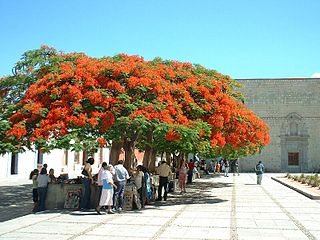
Caesalpinioideae is a botanical name at the rank of subfamily, placed in the large family Fabaceae or Leguminosae. Its name is formed from the generic name Caesalpinia. It is known also as the peacock flower subfamily. The Caesalpinioideae are mainly trees distributed in the moist tropics, but include such temperate species as the honeylocust and Kentucky coffeetree. It has the following clade-based definition:
The most inclusive crown clade containing Arcoa gonavensisUrb. and Mimosa pudicaL., but not Bobgunnia fistuloides(Harms) J. H. Kirkbr. & Wiersema, Duparquetia orchidaceaBaill., or Poeppigia proceraC.Presl

Liriodendron is a genus of two species of characteristically large trees, deciduous over most of their populations, in the magnolia family (Magnoliaceae).

Podocarpus totara is a species of podocarp tree endemic to New Zealand. It grows throughout the North Island and northeastern South Island in lowland, montane and lower subalpine forest at elevations of up to 600 m.

Liriodendron tulipifera—known as the tulip tree, American tulip tree, tulipwood, tuliptree, tulip poplar, whitewood, fiddletree, lynn-tree, hickory-poplar, and yellow-poplar—is the North American representative of the two-species genus Liriodendron, and the tallest eastern hardwood. It is native to eastern North America from Southern Ontario and possibly southern Quebec to Illinois eastward to southwestern Massachusetts and Rhode Island, and south to central Florida and Louisiana. It can grow to more than 50 m (160 ft) in virgin cove forests of the Appalachian Mountains, often with no limbs until it reaches 25–30 m (80–100 ft) in height, making it a very valuable timber tree. The tallest individual at the present time (2021) is one called the Fork Ridge Tulip Tree at a secret location in the Great Smoky Mountains of North Carolina. Repeated measurements by laser and tape-drop have shown it to be 191 feet 10 inches (58.47 m) in height. This is the tallest known individual tree in eastern North America.

The European pied flycatcher is a small passerine bird in the Old World flycatcher family. One of the four species of Western Palearctic black-and-white flycatchers, it hybridizes to a limited extent with the collared flycatcher. It breeds in most of Europe and across the Western Palearctic. It is migratory, wintering mainly in tropical Africa. It usually builds its nests in holes on oak trees. This species practices polygyny, usually bigamy, with the male travelling large distances to acquire a second mate. The male will mate with the secondary female and then return to the primary female in order to help with aspects of child rearing, such as feeding.
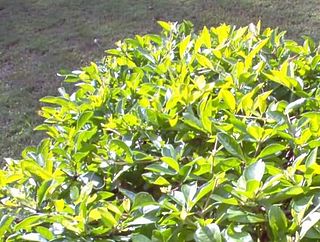
Pruning is a horticultural, arboricultural, and silvicultural practice involving the selective removal of certain parts of a plant, such as branches, buds, or roots.

The Indochinese green magpie or yellow-breasted magpie, is a passerine bird of the crow family, Corvidae. It is native to mainland southeast Asia (Indochina) and adjacent China.

Entandrophragma cylindricum is a tree of the genus Entandrophragma of the family Meliaceae. It is commonly known as sapele or sapelli or sapele mahogany, as well as aboudikro, assi, and muyovu.
Monocarpic plants are those that flower and set seeds only once, and then die.

Actinidia arguta, the hardy kiwi, is a perennial vine native to Japan, Korea, Northern China, and the Russian Far East. It produces a small kiwifruit without the hair-like fiber covering the outside, unlike most other species of the genus.

Acer is a genus of trees and shrubs commonly known as maples. The genus is placed in the family Sapindaceae. There are approximately 132 species, most of which are native to Asia, with a number also appearing in Europe, northern Africa, and North America. Only one species, Acer laurinum, extends to the Southern Hemisphere. The type species of the genus is the sycamore maple, Acer pseudoplatanus, the most common maple species in Europe. Maples usually have easily recognizable palmate leaves and distinctive winged fruits. The closest relatives of the maples are the horse chestnuts. Maple syrup is made from the sap of some maple species. It is one of the most common genera of trees in Asia. Numerous maple species are widely grown in gardens where many are especially valued for their autumn colour.

Barle Valley is a 1,540 acres (620 ha) Site of Special Scientific Interest within Exmoor National Park, situated in the counties of Devon and Somerset through which the River Barle flows. It was notified in its current form under the Wildlife and Countryside Act in 1988. The site includes the Somerset Wildlife Trust's Mounsey Wood Nature Reserve and the Knaplock and North Barton SSSI which has been notified since 1954.
Tachigali tessmannii is a species of leguminous species of tree in the family Fabaceae. It is found only in Peru.
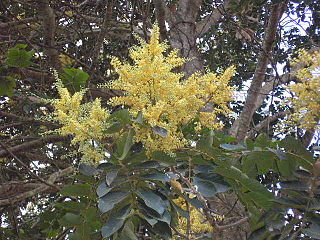
Tachigali is a flowering plant genus in the legume family (Fabaceae) that contains 54 species.

Ocotea porosa, commonly called imbuia or Brazilian walnut, is a species of plant in the Lauraceae family. Its wood is very hard, and it is a major commercial timber species in Brazil.

The Cuban moist forests is a tropical moist broadleaf forest ecoregion that occupies 21,400 km2 on Cuba and Isla de la Juventud. The ecoregion receives more than 2,000 mm (79 in) of rainfall annually, and does not have a dry season. Soils are usually derived from quartz, limestone, or serpentinites. Cuban moist forests can be differentiated into lowland forests, sub-montane forests, and montane forests.

Tachigali versicolor or the suicide tree is a species of tree found from Costa Rica to western Colombia. It is monocarpic, flowering only once before dying, which gives rise to its common name of the "suicide tree".
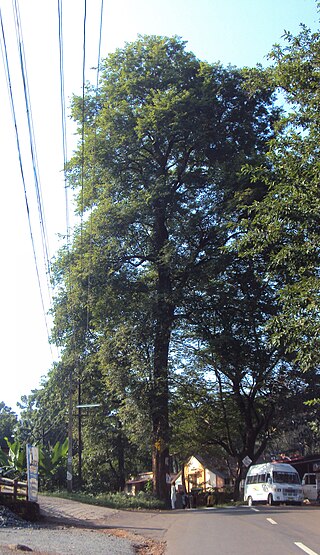
Dalbergia latifolia is a premier timber species, also known as the Indian rosewood. It is native to low-elevation tropical monsoon forests of south east India. Some common names in English include rosewood, Bombay blackwood, roseta rosewood, East Indian rosewood, reddish-brown rosewood, Indian palisandre, and Java palisandre. Its Indian common names are beete, and satisal. The tree grows to 40 metres (130 ft) in height and is evergreen, but locally deciduous in drier subpopulations.

Lobelia hypoleuca, common names kuhiʻaikamoʻowahie, 'ōpelu, liua, or mo'owahie, is one of several species in the genus Lobelia endemic to Hawaii though cultivated elsewhere. It is found in nature on the islands of Kauaʻi, Oʻahu, Molokaʻi, Lānaʻi, Maui and Hawaiʻi.
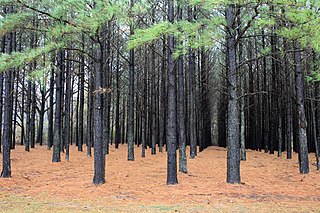
A tree plantation, forest plantation, plantation forest, timber plantation or tree farm is a forest planted for high volume production of wood, usually by planting one type of tree as a monoculture forest. The term tree farm also is used to refer to tree nurseries and Christmas tree farms.

















